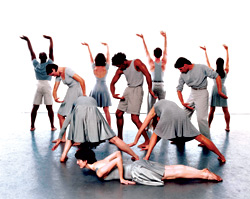For 15 years, UW World Dance Series director Matthew Krashan has moved heaven and earth to ensure that local dance mavens get their annual update on the latest works of favorite choreographic son Mark Morris. But the Morris company’s performances next week at Meany Hall will be the last in Seattle for the foreseeable future. The company that once lived hand to mouth here and performed at the old Central District On the Boards is now a Brooklyn-based world dance resource. In addition to works for his own dancers, Morris now executes commissions for leading ballet companies—ABT, San Francisco—and directs operatic-scale evenings for the likes of Britain’s Royal Opera. His smaller chamber pieces have already been seen in Seattle many times, and the UW simply can’t afford to produce major works, such as Four Saints in Three Acts and Dido and Aeneas—especially because Morris has insisted on live musical accompaniment since his company’s founding 25 years ago.
That is why it is so gratifying that Morris’ goodbye-for-now program (Thursday, May 4–Saturday, May 6) includes not just the sampling of new and nearly new works we’re accustomed to—the Stephen Foster parlor-song suite Somebody’s Coming to See Me Tonight (1995), Rock of Ages (2005) to a Schubert trio, and Cargo (2006, inspired by Darius Milhaud’s 1920s “jazz” score Le Création du Monde). Morris has authorized a break in his own live-music-only rule so his hometown audience can see once more the piece that identified him at a stroke as a major American choreographer: Gloria (1981, revised 1984).
Set to a series of solos, duets, and choruses expanding on the “Gloria” section of the Catholic Mass by Antonio Vivaldi, Gloria is almost impossible to tour, but it’s basic-basic to an appreciation of Morris’ whole life output. He’s made bigger dances, more dramatic dances, but none more expressive of both his aesthetic and his worldview. Beginning with unforgettable images of effort and impairment, the movement for the 10 dancers runs a gamut from school-yard horseplay to almost hysteric, constantly quashed aspiration. Most of the time, each performer follows his or her lonely path, but from time to time they come together almost inadvertently, gravely exchanging postures and gestures, then drifting apart again.
Vivaldi’s score is not at all “spiritual.” It’s jolly, propulsive, showy, totally worldly. Somehow, that makes the struggles and strivings of the dancers seem all the more spiritually important. By the brilliant fugal finale, you find yourself rooting for them, wanting them to win their endless struggle with gravity. There’s not a tear-jerking moment in the show, yet many find themselves in tears by its end.
Nearly all the dancers who “created” Gloria in its definitive 1984 version were close personal friends of Morris and continued to form the core of the company during his next hugely productive decade (including a fraught, three-year stint as Belgium’s official dance company, which led to the creation of Morris’ magnum opus L’Allegro, il Penseroso, ed il Moderato). But dancers age as quickly as mayflies, and none of the original 10 performers of Gloria will appear at Meany next week. I suspect that this, painful as it must be for Morris and his oldest fans, will not impair the work’s impact: A celebration of life danced on the edge of distress, isolation, and despair, its language is one every mortal understands.








